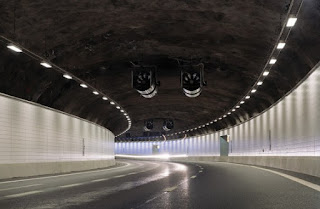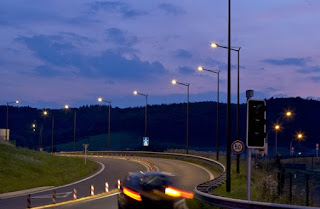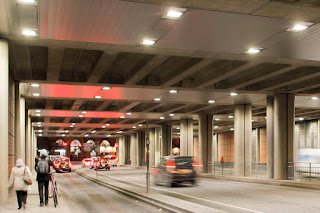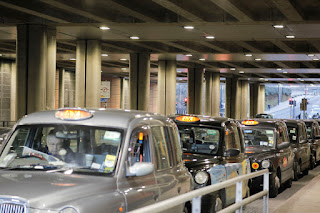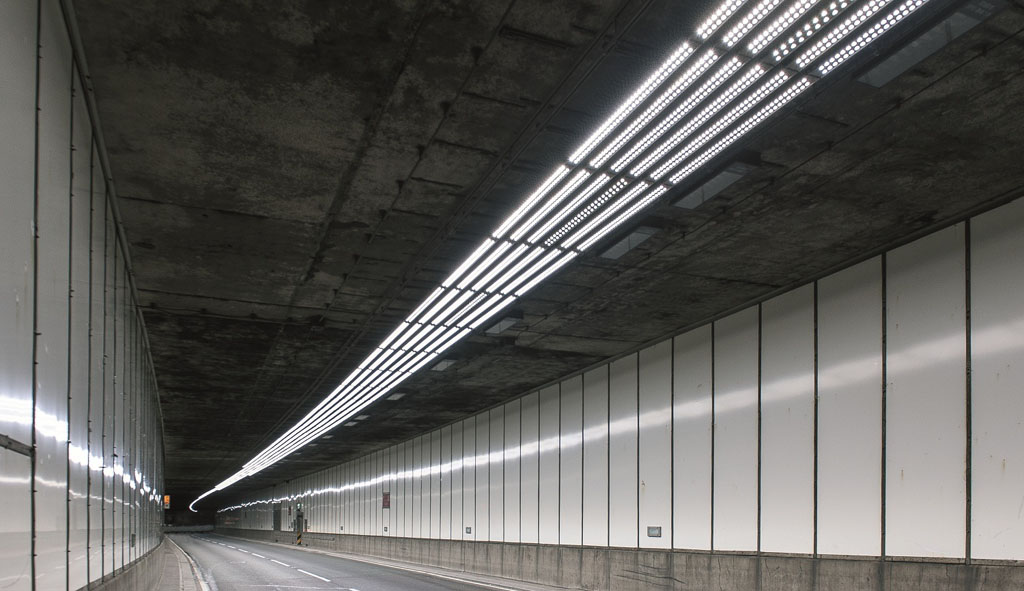TAG | tunnel lighting
When lighting traffic routes the primary concern is safety and comfort, especially in conflict areas where traffic may be merging, becoming compressed or changing direction or in stretches of open road where traffic speeds may be high.
To ensure safety on stretches of open road involves visibility over relatively large distances, generally 30 metres or more, to account for the high traffic speeds that may be present. To achieve this at below optimal lighting levels for our eye requires a different approach to lighting which is to light the road surface, making objects appear in silhouette against the bright surface. However where speeds can be expected to be lower and objects closer, such as in conflict areas or tunnels, this no longer works as the road surface may be visually below the object outline preventing it appearing as a silhouette, and therefore the objects themselves need to be lit as opposed to the road surface. These changing requirements are reflected in the design criteria, luminance for traffic routes and illuminance for conflict areas and tunnels.
In Europe lighting requirements for roads are given in the document EN 13201 Road Lighting. This document is in multiple parts and describes how to decide the relevant road class and then the lighting requirements that this class requires. Lighting requirements for tunnel lighting are given in document CR 14380 Lighting Applications – Tunnel Lighting. However this document is a report not a standard and should be used in conjunction with local practice.
Best practice
The luminaires should be appropriate for the local climactic conditions. For open areas the fitting should ideally be shaped and mounted to minimise windage, which is the effect of wind producing a stress on the luminaire and all mounting equipment. All brackets, columns, etc. should be rated to withstand the maximum windage that will be encountered. In enclosed spaces such as tunnels the luminaire should be capable of withstanding mechanical shock caused by possibly near-continuous vibration as well as the poor air-quality which may contain corrosive pollutants.
Positioning of luminaires should provide maximum guidance as to the geometry of the road, giving a coherent visual story to a road user. It should be ensured that some light spills behind the edges of the road to allow visibility of objects off the carriageway that may pose a hazard, however this should be controlled to prevent excessive obtrusive light.
For tunnels the lighting should provide a smooth transition between the entrance, tunnel interior and exit zones allow the eye to adjust to the different ambient light levels. All tunnel surfaces should be lit to ensure a comfortable and safe passage through the space.
For both roads and tunnels care should be taken to prevent distracting flicker caused by bright sources of light travelling in a periodic way through the field of view (the car windscreen). This can give a similar effect to a stationary light dimming and increasing in response to the electrical supply.
Taking control
The use of photocell switching to react to levels of daylight or timed on/off can ensure the correct light at the required time. Dimming of lighting at hours of low usage, such as the use of bi-power dimming which reduces the lighting during the early hours of the day, can significantly reduce energy usage. In addition a more advanced lighting control system can allow the lighting levels to be set to the requirements of a situation, such as raising the lighting levels at the scene of an accident or traffic congestion whilst allowing central monitoring of lighting to ensure peak light management with optimal maintenance.
High efficiency control gear that minimise electrical losses, especially for higher power lamps, help increase energy efficiency, whilst the use of a high quality optic to control the light helps reduce waste light that falls outside the target area.
Visit www.novelenergylighting.com today to explore our Megaman LED retrofit solutions, or call: 0208-540-8287, email: sales@novelenergylighting.com
Key Products
Road Lighting
– Isaro
– Isaro LED
Tunnel Lighting
– GTLED
led streetlights · led tunnel · Novel Energy Lighting · road lighting · thorn gtled · thorn isaro LED · thorn led · thorn lighting · tunnel lighting
At a special Lux Review conference on road tunnel lighting in association with Holophane and Carandini, experts explored issues including LEDs, controls and driver safety in tunnels
led controls · LED lamps · led lighting · led tunnel lighting · Novel Energy Lighting · tunnel lighting
19
LEDs cut costs in North London underpass
Comments off · Posted by admin in LED, LED downlights, LED Floodlights, Philips LED
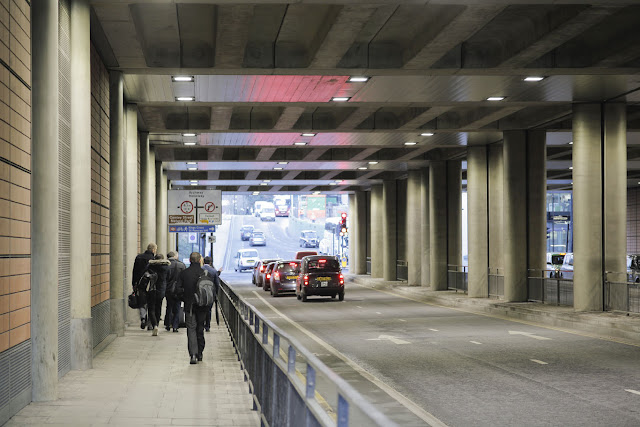
This underpass near King’s Cross and St Pancras stations in North London is saving money on energy and maintenance since it had its old metal halide lights replaced with specially designed LED road tunnel luminaires from Philips.
The St Pancras Road underpass is a busy road, cycle and pedestrian route to the two major train stations, as well as providing access to Camden Council’s new offices. It was previously lit by around 100 twin-lamp metal halide fittings and the council saw an opportunity to visually improve what had become a gloomy and uninviting area. This was a ‘spend to save’ initiative to take advantage of energy-efficiency gains and lower maintenance costs while also reducing carbon emissions.
The lighting design was carried out by Philips and the new luminaires were installed by main contractor SPIE. SPIE’s John Broster said: ‘The previous luminaires were fitted into the soffit of the underpass and as this is a concrete strutted roof it would have been impractical to alter it. We needed a solution that could provide a direct replacement for the existing fittings.’
The stainless steel luminaires have been installed on a one-for-one replacement basis, to provide energy savings of more than 50 per cent. The new lighting has increased light levels and uniformity to remove the gloom, while the 4000K neutral white colour temperature has created a better and more inviting visual environment for users of the underpass. The tunnel feels safer and more pleasant.
The project also provided an ideal opportunity to make better use of lighting control. ‘As this is a short underpass the lighting only requires one-step dimming and we were able to adjust the existing system, using high light levels during the day and dimming at night to minimise the contrast for drivers entering the underpass,’ said Broster.
The council has achieved a significant reduction in energy consumption, while also reducing maintenance costs as the luminaires are expected to be virtually maintenance-free throughout their lifetime, and should pay for themselves in about five years.
Contact Novel Energy Lighting to discuss your LED lighting retrofit requirements. We work hand in hand with the major lighting manufacturers like Philips to specify, supply, and install projects. Tel: 0208-540-8287. Email: sales@novelenergylighting.com
led floods · LED lamps · led lighting · LED luminaires · led tunnel lighting · lux · Novel Energy Lighting · philips led · street lighting · tunnel lighting · urban lighting
12
Light at the end of the tunnel (and slightly dimmer light in the middle)
Comments off · Posted by admin in LED, Philips LED
Until recently, this tunnel in Stoke-on-Trent, England, had to be regularly closed to change failed lamps, causing disruption to drivers.
I have reduced my overall maintenance costs, saved a substantial amount of money in energy costs, reduced the carbon footprint and reduced the risks for the operatives’Paul Diamond, Amey
amey · energy efficiency · energy saving lighting · highway lighting · led lighting · Novel Energy Lighting · philips led · philips linear led · street lighting · tunnel lighting


